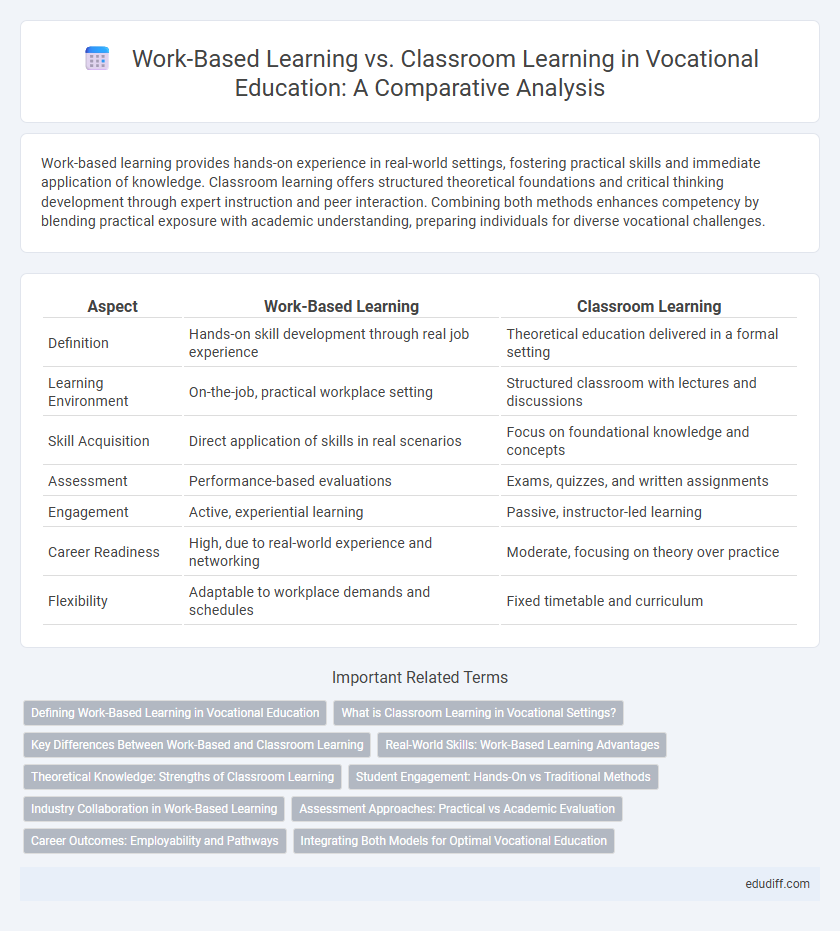Work-based learning provides hands-on experience in real-world settings, fostering practical skills and immediate application of knowledge. Classroom learning offers structured theoretical foundations and critical thinking development through expert instruction and peer interaction. Combining both methods enhances competency by blending practical exposure with academic understanding, preparing individuals for diverse vocational challenges.
Table of Comparison
| Aspect | Work-Based Learning | Classroom Learning |
|---|---|---|
| Definition | Hands-on skill development through real job experience | Theoretical education delivered in a formal setting |
| Learning Environment | On-the-job, practical workplace setting | Structured classroom with lectures and discussions |
| Skill Acquisition | Direct application of skills in real scenarios | Focus on foundational knowledge and concepts |
| Assessment | Performance-based evaluations | Exams, quizzes, and written assignments |
| Engagement | Active, experiential learning | Passive, instructor-led learning |
| Career Readiness | High, due to real-world experience and networking | Moderate, focusing on theory over practice |
| Flexibility | Adaptable to workplace demands and schedules | Fixed timetable and curriculum |
Defining Work-Based Learning in Vocational Education
Work-based learning in vocational education involves acquiring practical skills and industry experience through direct engagement in real work environments, fostering hands-on expertise and professional competence. This form of learning emphasizes collaboration with employers, mentorship, and task-oriented training that bridges theoretical knowledge and practical application. Unlike traditional classroom learning, it prioritizes experiential learning, adaptability, and job readiness critical for career development in technical and trade professions.
What is Classroom Learning in Vocational Settings?
Classroom learning in vocational settings involves structured, instructor-led lessons that provide foundational knowledge and theoretical concepts essential to specific trades or professions. This approach includes lectures, demonstrations, and assessments designed to develop cognitive skills and technical understanding before hands-on practice. It emphasizes curriculum-based instruction aligned with industry standards to prepare students for practical application in work-based environments.
Key Differences Between Work-Based and Classroom Learning
Work-based learning emphasizes hands-on experience and real-world skill development through direct engagement in workplace tasks, whereas classroom learning focuses on theoretical knowledge delivered in a structured academic environment. Work-based learning provides immediate application of skills, fosters problem-solving abilities, and enhances employability, while classroom learning prioritizes foundational concepts and standardized curriculum comprehension. Key differences include the learning setting, assessment methods, and the balance between practical versus theoretical instruction.
Real-World Skills: Work-Based Learning Advantages
Work-based learning offers immersive experiences that directly develop real-world skills such as problem-solving, communication, and teamwork, which are essential in vocational careers. This hands-on approach enables learners to apply theoretical knowledge in practical settings, enhancing job readiness and adaptability. Employers value work-based learning for producing candidates who can seamlessly integrate into professional environments and meet industry standards.
Theoretical Knowledge: Strengths of Classroom Learning
Classroom learning excels in delivering structured theoretical knowledge through systematic curricula designed by educational experts, ensuring comprehensive coverage of foundational concepts. It provides a controlled environment where students engage with abstract theories, critical thinking exercises, and detailed explanations that are often difficult to replicate in work-based settings. This method allows for standardized assessments and immediate feedback, reinforcing deep understanding of complex subjects essential for vocational proficiency.
Student Engagement: Hands-On vs Traditional Methods
Work-based learning significantly enhances student engagement by providing hands-on experiences that directly apply theoretical knowledge to real-world tasks, fostering practical skills and problem-solving abilities. Classroom learning, while foundational for conceptual understanding, often relies on traditional methods such as lectures and textbooks, which may limit active participation and immediate application. Integrating experiential learning opportunities in vocational education bridges the gap between theory and practice, increasing motivation and retention among students.
Industry Collaboration in Work-Based Learning
Work-based learning integrates real-world industry collaboration, providing students with hands-on experience and direct exposure to workplace practices that classroom learning often lacks. Partnering with companies ensures curriculum relevance, skill development aligned with employer needs, and opportunities for networking and mentorship. This industry collaboration enhances employability and bridges the gap between theoretical knowledge and practical application in vocational education.
Assessment Approaches: Practical vs Academic Evaluation
Work-based learning emphasizes practical assessment methods such as on-the-job performance reviews, real-time problem solving, and competency demonstrations that directly reflect workplace skills. Classroom learning relies on academic evaluations including written exams, standardized tests, and theoretical assignments to measure knowledge retention and conceptual understanding. Combining practical assessments with academic evaluation creates a comprehensive approach that validates both skill proficiency and cognitive learning in vocational education.
Career Outcomes: Employability and Pathways
Work-based learning enhances employability by providing hands-on experience and industry-relevant skills that align directly with labor market demands. Classroom learning offers foundational knowledge and theoretical frameworks critical for understanding complex concepts, which supports diverse career pathways and opportunities for further education. Combining both methods optimizes career outcomes by bridging practical expertise with academic understanding, leading to increased job readiness and adaptable career trajectories.
Integrating Both Models for Optimal Vocational Education
Integrating work-based learning with traditional classroom instruction enhances vocational education by combining hands-on experience and theoretical knowledge, fostering practical skills alongside critical thinking. Employers gain a more competent workforce, while students develop industry-relevant competencies through real-world applications supported by academic frameworks. This blended approach bridges skill gaps, increases employability, and drives economic growth by aligning education with labor market demands.
Work-Based Learning vs Classroom Learning Infographic

 edudiff.com
edudiff.com